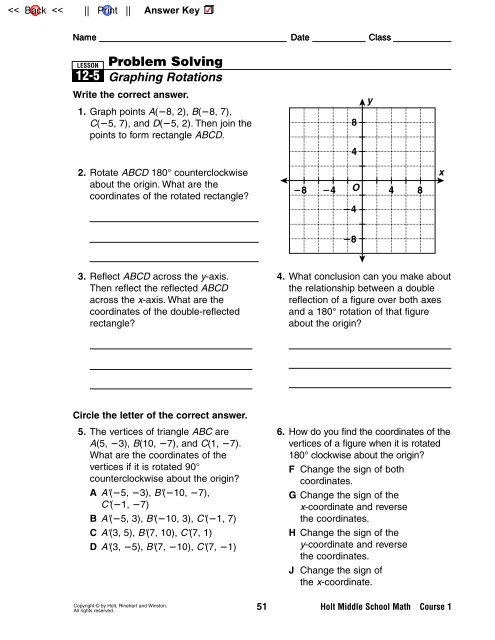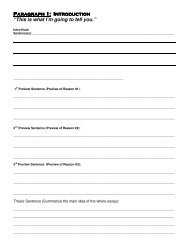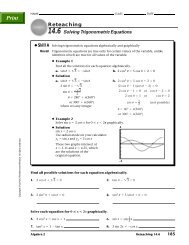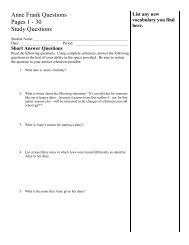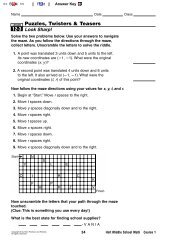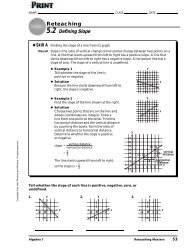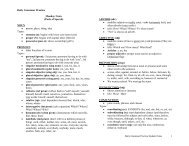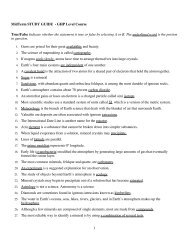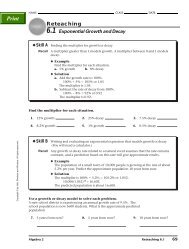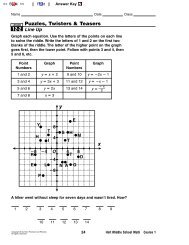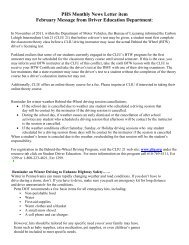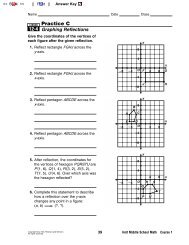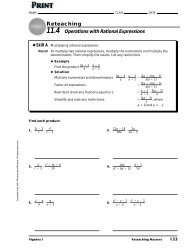Problem Solving 12-5 - Parkland School District
Problem Solving 12-5 - Parkland School District
Problem Solving 12-5 - Parkland School District
You also want an ePaper? Increase the reach of your titles
YUMPU automatically turns print PDFs into web optimized ePapers that Google loves.
Name Date Class<br />
LESSON<br />
<strong>12</strong>-5<br />
<strong>Problem</strong> <strong>Solving</strong><br />
Graphing Rotations<br />
Write the correct answer.<br />
1. Graph points A(8, 2), B(8, 7),<br />
C(5, 7), and D(5, 2). Then join the<br />
points to form rectangle ABCD.<br />
8<br />
4<br />
y<br />
2. Rotate ABCD 180° counterclockwise<br />
about the origin. What are the<br />
coordinates of the rotated rectangle<br />
8<br />
4<br />
O 4 8<br />
x<br />
4<br />
8<br />
3. Reflect ABCD across the y-axis.<br />
Then reflect the reflected ABCD<br />
across the x-axis. What are the<br />
coordinates of the double-reflected<br />
rectangle<br />
4. What conclusion can you make about<br />
the relationship between a double<br />
reflection of a figure over both axes<br />
and a 180° rotation of that figure<br />
about the origin<br />
Circle the letter of the correct answer.<br />
5. The vertices of triangle ABC are<br />
A(5, 3), B(10, 7), and C(1, 7).<br />
What are the coordinates of the<br />
vertices if it is rotated 90°<br />
counterclockwise about the origin<br />
A A'(5, 3), B'(10, 7),<br />
C'(1, 7)<br />
B A'(5, 3), B'(10, 3), C'(1, 7)<br />
C A'(3, 5), B'(7, 10), C'(7, 1)<br />
D A'(3, 5), B'(7, 10), C'(7, 1)<br />
6. How do you find the coordinates of the<br />
vertices of a figure when it is rotated<br />
180° clockwise about the origin<br />
F Change the sign of both<br />
coordinates.<br />
G Change the sign of the<br />
x-coordinate and reverse<br />
the coordinates.<br />
H Change the sign of the<br />
y-coordinate and reverse<br />
the coordinates.<br />
J Change the sign of<br />
the x-coordinate.<br />
Copyright © by Holt, Rinehart and Winston.<br />
51 Holt Middle <strong>School</strong> Math Course 1<br />
All rights reserved.
LESSON<br />
<strong>12</strong>-5<br />
<strong>Problem</strong> <strong>Solving</strong><br />
Graphing Rotations<br />
Write the correct answer.<br />
1. Graph points A(8, 2), B(8, 7),<br />
C(5, 7), and D(5, 2). Then join the<br />
points to form rectangle ABCD.<br />
Check students’ graphs.<br />
2. Rotate ABCD 180° counterclockwise<br />
about the origin. What are the<br />
coordinates of the rotated rectangle<br />
Check students’ graphs;<br />
A'(8, 2); B'(8, 7);<br />
C'(5, 7); D'(5, 2)<br />
3. Reflect ABCD across the y-axis.<br />
Then reflect the reflected ABCD<br />
across the x-axis. What are the<br />
coordinates of the double-reflected<br />
rectangle<br />
Check students’ graphs;<br />
A''(8, 2);B''(8, 7);<br />
C''(5, 7); D''(5, 2)<br />
Circle the letter of the correct answer.<br />
5. The vertices of triangle ABC are<br />
A(5, 3), B(10, 7), and C(1, 7).<br />
What are the coordinates of the<br />
vertices if it is rotated 90°<br />
counterclockwise about the origin<br />
A A'(5, 3), B'(10, 7),<br />
C'(1, 7)<br />
B A'(5, 3), B'(10, 3), C'(1, 7)<br />
C A'(3, 5), B'(7, 10), C'(7, 1)<br />
D A'(3, 5), B'(7, 10), C'(7, 1)<br />
B<br />
A<br />
8<br />
C<br />
8<br />
4<br />
D<br />
x<br />
4 O 4 8<br />
D'<br />
A'<br />
4<br />
8<br />
4. What conclusion can you make about<br />
the relationship between a double<br />
reflection of a figure over both axes<br />
and a 180° rotation of that figure<br />
about the origin<br />
They are the same<br />
transformation of the figure.<br />
6. How do you find the coordinates of the<br />
vertices of a figure when it is rotated<br />
180° clockwise about the origin<br />
F Change the sign of both<br />
coordinates.<br />
G Change the sign of the<br />
x-coordinate and reverse<br />
the coordinates.<br />
H Change the sign of the<br />
y-coordinate and reverse<br />
the coordinates.<br />
J Change the sign of<br />
the x-coordinate.<br />
y<br />
C'<br />
B'<br />
LESSON<br />
<strong>12</strong>-5<br />
Puzzles, Twisters & Teasers<br />
Which Way Did IT Go<br />
Compare the first figure to the second figure in each pair.<br />
Decide how the figure has been rotated: 90, 180, or 360.<br />
Circle the correct answer. Use the letters to solve the riddle.<br />
1. WXYZ W'X'Y'Z' D 90° rotation<br />
W (0, 0) W' (0, 0)<br />
X (3, 1) X' (3, 1) E 180° rotation<br />
Y (2, 3) Y' (2, 3)<br />
Z (1, 1) Z' (1, 1) C 360° rotation<br />
2. DEFG D'E'F'G' A 90° rotation<br />
D (6, 4) D' (4, 6)<br />
E (2, 4) E' (4, 2) Y 180° rotation<br />
F (0, 0) F' (0, 0)<br />
G (8, 0) G' (0, 8) O 360° rotation<br />
3. NOPQ N'O'P'Q' R 90° rotation<br />
N (0, 0) N' (0, 0)<br />
O (2, 4.5) O' (2, 4.5) K 180° rotation<br />
P (4.5, 6) P' (4.5, 6)<br />
Q (4.5, 1.5) Q' (4.5, 1.5) W 360° rotation<br />
4. LMN L'M'N' I 90° rotation<br />
L (1, 4) L' (1, 4)<br />
M (5, 3) M' (5, 3) U 180° rotation<br />
N (3, 1) N' (3, 1)<br />
E 360° rotation<br />
5. JKLM J'K'L'M' L 90° rotation<br />
J (0, 0) J' (0, 0)<br />
K (1, 4) K' (4, 1) G 180° rotation<br />
L (2, 4) L' (4, 2)<br />
M (4, 1) M' (1, 4) M 360° rotation<br />
What vegetable was not welcome on the Titanic A LEEK<br />
y<br />
4 Y'<br />
Z<br />
W X' x<br />
4 O 4<br />
X Z'<br />
Y 4<br />
y<br />
G'<br />
8<br />
D'<br />
D E<br />
4<br />
E'<br />
G<br />
x<br />
8 4 O F 4 8<br />
y<br />
P<br />
O<br />
4<br />
N Q x<br />
4 O 4<br />
Q'<br />
4<br />
P' O'<br />
y<br />
LL'<br />
4 M M'<br />
N N' x<br />
4 O 4<br />
y<br />
K L<br />
4<br />
N J M x<br />
4 O 4K'<br />
L'<br />
4<br />
M'<br />
Copyright © by Holt, Rinehart and Winston.<br />
51 Holt Middle <strong>School</strong> Math Course 1<br />
All rights reserved.<br />
Copyright © by Holt, Rinehart and Winston.<br />
52 Holt Middle <strong>School</strong> Math Course 1<br />
All rights reserved.<br />
LESSON<br />
<strong>12</strong>-6<br />
Exploration Recording Sheet<br />
Stretching and Shrinking<br />
You can stretch the triangle in the coordinate plane.<br />
3<br />
1. Label the height and width of the triangle.<br />
2. Create a new triangle by multiplying the dimensions<br />
by 2.<br />
3. Explain how the height and width of the triangle<br />
changed after the dimensions were multiplied by 2.<br />
The height and width each doubled.<br />
Think and Discuss<br />
4. Discuss real-world applications of stretches.<br />
3<br />
Possible answer: lengthening a pattern<br />
6<br />
5. Explain how many times the original triangle fits into the<br />
triangle you drew in Exercise 2.<br />
4 times<br />
6<br />
LESSON<br />
<strong>12</strong>-6<br />
Practice A<br />
Stretching and Shrinking<br />
Write the dimensions of each part<br />
of the figure. Stretch the figure as<br />
stated and give the new dimensions<br />
of each part.<br />
1. Original dimensions:<br />
horizontal: 2 squares<br />
and vertical: 3 squares<br />
2. Increase the horizontal dimension by<br />
a factor of 2.<br />
horizontal: 4 squares<br />
and vertical: 3 squares<br />
Write the dimensions of each part<br />
of the figure. Shrink the figure as<br />
stated and give the new dimensions<br />
of each part.<br />
4. Original dimensions:<br />
horizontal: 8 squares<br />
and vertical: 1 squares<br />
3. Increase the vertical dimension by a<br />
factor of 4.<br />
horizontal: 2 squares<br />
and vertical: <strong>12</strong> squares<br />
5. Decrease the vertical dimension by 6. Decrease the horizontal dimension<br />
multiplying by 1 3 .<br />
by a multiplying by 1 2 .<br />
horizontal: 8 squares<br />
horizontal: 4 squares<br />
and vertical: 1 3 square and vertical: 1 square<br />
7. If you decrease the vertical dimension of the photograph<br />
by a factor of 2, what are its new dimensions<br />
6 inches wide and 5 inches tall<br />
8. Using the photograph in Exercise 7. If you increase its<br />
horizontal dimension by a factor of 2, what are its new<br />
dimensions<br />
<strong>12</strong> inches wide and 10 inches tall<br />
10 in.<br />
6 in.<br />
Copyright © by Holt, Rinehart and Winston.<br />
54 Holt Middle <strong>School</strong> Math Course 1<br />
All rights reserved.<br />
Copyright © by Holt, Rinehart and Winston.<br />
55 Holt Middle <strong>School</strong> Math Course 1<br />
All rights reserved.<br />
Copyright © by Holt, Rinehart and Winston.<br />
79 Holt Middle <strong>School</strong> Math Course 1<br />
All rights reserved.


